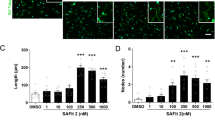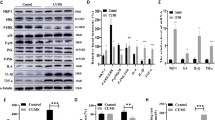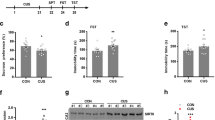Abstract
Major depressive disorder is often linked to stress. Although short-term stress is without effect in mice, prolonged stress leads to depressive-like behavior, indicating that an allostatic mechanism exists in this difference. Here we demonstrate that mice after short-term (1 h per day for 7 days) chronic restraint stress (CRS), do not display depressive-like behavior. Analysis of the hippocampus of these mice showed increased levels of neurotrophic factor-α1 (NF-α1; also known as carboxypeptidase E, CPE), concomitant with enhanced fibroblast growth factor 2 (FGF2) expression, and an increase in neurogenesis in the dentate gyrus. In contrast, after prolonged (6 h per day for 21 days) CRS, mice show decreased hippocampal NF-α1 and FGF2 levels and depressive-like responses. In NF-α1-knockout mice, hippocampal FGF2 levels and neurogenesis are reduced. These mice exhibit depressive-like behavior that is reversed by FGF2 administration. Indeed, studies in cultured hippocampal neurons reveal that NF-α1 treatment directly upregulates FGF2 expression through extracellular signal-regulated kinase-Sp1 signaling. Thus, during short-term CRS, hippocampal NF-α1 expression is upregulated and has a key role in preventing the onset of depressive-like behavior through enhanced FGF2-mediated neurogenesis. To evaluate the therapeutic potential of this pathway, we examined, rosiglitazone (Rosi), a PPARγ agonist, which has been shown to have antidepressant activity in rodents and humans. Rosi upregulates FGF2 expression in a NF-α1-dependent manner in hippocampal neurons. Mice fed Rosi show increased hippocampal NF-α1 levels and neurogenesis compared with controls, thereby indicating the antidepressant action of this drug. Development of drugs that activate the NF-α1/FGF2/neurogenesis pathway can offer a new approach to depression therapy.
This is a preview of subscription content, access via your institution
Access options
Subscribe to this journal
Receive 12 print issues and online access
$259.00 per year
only $21.58 per issue
Buy this article
- Purchase on Springer Link
- Instant access to full article PDF
Prices may be subject to local taxes which are calculated during checkout






Similar content being viewed by others
References
van Praag HM . Can stress cause depression? World J Biol Psychiatry 2005; 6: 5–22.
Maes MaM HY . The serotonin hypothesis of major depression. In: Psychopharmacology: The Fourth Generation of Progress. Raven Press: New York, 1994.
Schildkraut JJ . The catecholamine hypothesis of affective disorders: a review of supporting evidence. Am J Psychiatry 1965; 122: 509–522.
Jiang C, Salton SR . The role of neurotrophins in major depressive disorder. Transl Neurosci 2013; 4: 46–58.
Krishnan V, Nestler EJ . The molecular neurobiology of depression. Nature 2008; 455: 894–902.
Turner CA, Watson SJ, Akil H . The fibroblast growth factor family: neuromodulation of affective behavior. Neuron 2012; 76: 160–174.
Duman RS, Monteggia LM . A neurotrophic model for stress-related mood disorders. Biol Psychiatry 2006; 59: 1116–1127.
Voorhees JL, Tarr AJ, Wohleb ES, Godbout JP, Mo X, Sheridan JF et al. Prolonged restraint stress increases IL-6, reduces IL-10, and causes persistent depressive-like behavior that is reversed by recombinant IL-10. PLoS One 2013; 8: e58488.
McEwen BS . The neurobiology of stress: from serendipity to clinical relevance. Brain Res 2000; 886: 172–189.
Duman RS, Malberg J, Thome J . Neural plasticity to stress and antidepressant treatment. Biol Psychiatry 1999; 46: 1181–1191.
Warner-Schmidt JL, Duman RS . Hippocampal neurogenesis: opposing effects of stress and antidepressant treatment. Hippocampus 2006; 16: 239–249.
Kempton MJ, Salvador Z, Munafo MR, Geddes JR, Simmons A, Frangou S et al. Structural neuroimaging studies in major depressive disorder. Meta-analysis and comparison with bipolar disorder. Arch Gen Psychiatry 2011; 68: 675–690.
Arnone D, McKie S, Elliott R, Juhasz G, Thomas EJ, Downey D et al. State-dependent changes in hippocampal grey matter in depression. Mol Psychiatry 2012; 18: 1265–1272.
Boldrini M, Underwood MD, Hen R, Rosoklija GB, Dwork AJ, John Mann J et al. Antidepressants increase neural progenitor cells in the human hippocampus. Neuropsychopharmacology 2009; 34: 2376–2389.
Reif A, Fritzen S, Finger M, Strobel A, Lauer M, Schmitt A et al. Neural stem cell proliferation is decreased in schizophrenia, but not in depression. Mol Psychiatry 2006; 11: 514–522.
Djavadian RL . Serotonin and neurogenesis in the hippocampal dentate gyrus of adult mammals. Acta Neurobiol Exp (Wars) 2004; 64: 189–200.
Sen S, Duman R, Sanacora . Serum brain-derived neurotrophic factor, depression, and antidepressant medications: meta-analyses and implications. Biol Psychiatry 2008; 64: 527–532.
Turner CA, Clinton SM, Thompson RC, Watson SJ Jr, Akil H . Fibroblast growth factor-2 (FGF2) augmentation early in life alters hippocampal development and rescues the anxiety phenotype in vulnerable animals. Proc Nati Acad Sci USA 2011; 108: 8021–8025.
Turner CA, Calvo N, Frost DO, Akil H, Watson SJ . The fibroblast growth factor system is downregulated following social defeat. Neurosci Lett 2008; 430: 147–150.
Elsayed M, Banasr M, Duric V, Fournier NM, Licznerski P, Duman RS . Antidepressant effects of fibroblast growth factor-2 in behavioral and cellular models of depression. Biol Psychiatry 2012; 72: 258–265.
Cheng Y, Cawley NX, Loh YP . Carboxypeptidase E/NFα1: a new neurotrophic factor against oxidative stress-induced apoptotic cell death mediated by ERK and PI3-K/AKT pathways. PLoS One 2013; 8: e71578.
Fricker LD, Snyder SH . Enkephalin convertase: purification and characterization of a specific enkephalin-synthesizing carboxypeptidase localized to adrenal chromaffin granules. Proc Natl Acad Sci USA 1982; 79: 3886–3890.
Hook VY, Eiden LE, Brownstein MJ . A carboxypeptidase processing enzyme for enkephalin precursors. Nature 1982; 295: 341–342.
Rodriguiz RM, Wilkins JJ, Creson TK, Biswas R, Berezniuk I, Fricker AD et al. Emergence of anxiety-like behaviours in depressive-like Cpefat/fat mice. Int J Neuropsychopharmacol 2013; 16: 1623–1634.
Cawley NX, Wetsel WC, Murthy SR, Park JJ, Pacak K, Loh YP . New roles of carboxypeptidase E in endocrine and neural function and cancer. Endocr Rev 2012; 33: 216–253.
Woronowicz A, Cawley NX, Loh YP . Carbamazepine prevents hippocampal neurodegeneration in mice lacking the neuroprotective protein, carboxypetidase E. Clinic Pharmacol Biopharmaceut 2012; S1: 002; doi:10.4172/2167-065X.S1-002.
Berton O, Nestler EJ . New approaches to antidepressant drug discovery: beyond monoamines. Nat Rev Neurosci 2006; 7: 137–151.
Eissa Ahmed AA, Al-Rasheed NM, Al-Rasheed NM . Antidepressant-like effects of rosiglitazone, a PPARgamma agonist, in the rat forced swim and mouse tail suspension tests. Behav Pharmacol 2009; 20: 635–642.
Rasgon NL, Kenna HA, Williams KE, Powers B, Wroolie T, Schatzberg AF . Rosiglitazone add-on in treatment of depressed patients with insulin resistance: a pilot study. Scientific World J 2010; 10: 321–328.
Murthy SR, Thouennon E, Li WS, Cheng Y, Bhupatkar J, Cawley NX et al. Carboxypeptidase E protects hippocampal neurons during stress in male mice by up-regulating pro-survival BCL2 protein expression. Endocrinology 2013; 154: 3284–3293.
Meerlo P, Easton A, Bergmann BM, Turek FW . Restraint increases prolactin and REM sleep in C57BL/6J mice but not in BALB/cJ mice. Am J Physiol Reg I 2001; 281: R846–R854.
Willner P, Towell A, Sampson D, Sophokleous S, Muscat R . Reduction of sucrose preference by chronic unpredictable mild stress, and its restoration by a tricyclic antidepressant. Psychopharmacology 1987; 93: 358–364.
Fukui M, Rodriguiz RM, Zhou J, Jiang SX, Phillips LE, Caron MG et al. Vmat2 heterozygous mutant mice display a depressive-like phenotype. J Neurosci 2007; 27: 10520–10529.
Woronowicz A, Koshimizu H, Chang SY, Cawley NX, Hill JM, Rodriguiz RM et al. Absence of carboxypeptidase E leads to adult hippocampal neuronal degeneration and memory deficits. Hippocampus 2008; 18: 1051–1063.
Cawley NX, Zhou J, Hill JM, Abebe D, Romboz S, Yanik T et al. The carboxypeptidase E knockout mouse exhibits endocrinological and behavioral deficits. Endocrinology 2004; 145: 5807–5819.
Jimenez SK, Sheikh F, Jin Y, Detillieux KA, Dhaliwal J, Kardami E et al. Transcriptional regulation of FGF-2 gene expression in cardiac myocytes. Cardiovasc Res 2004; 62: 548–557.
Tang W, Pan Q, Sun F, Ma J, Tang S, Le K et al. Involvement of Sp1 binding sequences in basal transcription of the rat fibroblast growth factor-2 gene in neonatal cardiomyocytes. Life Sci 2009; 84: 421–427.
Sharma AN, Elased KM, Lucot JB . Rosiglitazone treatment reversed depression- but not psychosis-like behavior of db/db diabetic mice. J Psychopharmacol 2012; 26: 724–732.
Shockley KR, Lazarenko OP, Czernik PJ, Rosen CJ, Churchill GA, Lecka-Czernik B . PPARgamma2 nuclear receptor controls multiple regulatory pathways of osteoblast differentiation from marrow mesenchymal stem cells. J Cell Biochem 2009; 106: 232–246.
Czeh B, Michaelis T, Watanabe T, Frahm J, de Biurrun G, van Kampen M et al. Stress-induced changes in cerebral metabolites, hippocampal volume, and cell proliferation are prevented by antidepressant treatment with tianeptine. Proc Natil Acad Sci USA 2001; 98: 12796–12801.
Santiago JJ, Ma X, McNaughton LJ, Nickel BE, Bestvater BP, Yu L et al. Preferential accumulation and export of high molecular weight FGF-2 by rat cardiac non-myocytes. Cardiovasc Res 2011; 89: 139–147.
Florkiewicz RZ, Baird A, Gonzalez AM . Multiple forms of bFGF: differential nuclear and cell surface localization. Growth Factors 1991; 4: 265–275.
Schiera G, Proia P, Alberti C, Mineo M, Savettieri G, Di Liegro I . Neurons produce FGF2 and VEGF and secrete them at least in part by shedding extracellular vesicles. J Cell Mol Med 2007; 11: 1384–1394.
Grothe C, Schulze A, Semkova I, Muller-Ostermeyer F, Rege A, Wewetzer K . The high molecular weight fibroblast growth factor-2 isoforms (21,000 mol. wt and 23,000 mol. wt) mediate neurotrophic activity on rat embryonic mesencephalic dopaminergic neurons in vitro. Neuroscience 2000; 100: 73–86.
Meisinger C, Grothe C . Differential expression of FGF-2 isoforms in the rat adrenal medulla during postnatal development in vivo. Brain Res 1997; 757: 291–294.
Meisinger C, Grothe C . Differential regulation of fibroblast growth factor (FGF)-2 and FGF receptor 1 mRNAs and FGF-2 isoforms in spinal ganglia and sciatic nerve after peripheral nerve lesion. J Neurochem 1997; 68: 1150–1158.
Abraham IM, Meerlo P, Luiten PG . Concentration dependent actions of glucocorticoids on neuronal viability and survival. Dose Response 2006; 4: 38–54.
Uno H, Tarara R, Else JG, Suleman MA, Sapolsky RM . Hippocampal damage associated with prolonged and fatal stress in primates. J Neurosci 1989; 9: 1705–1711.
Jin K, LaFevre-Bernt M, Sun Y, Chen S, Gafni J, Crippen D et al. FGF-2 promotes neurogenesis and neuroprotection and prolongs survival in a transgenic mouse model of Huntington's disease. Proc Natil Acad Sci USA 2005; 102: 18189–18194.
Wagner JP, Black IB, DiCicco-Bloom E . Stimulation of neonatal and adult brain neurogenesis by subcutaneous injection of basic fibroblast growth factor. J Neurosci 1999; 19: 6006–6016.
Dhabhar FS, Burke HM, Epel ES, Mellon SH, Rosser R, Reus VI et al. Low serum IL-10 concentrations and loss of regulatory association between IL-6 and IL-10 in adults with major depression. J Psychiatr Res 2009; 43: 962–969.
Mesquita AR, Correia-Neves M, Roque S, Castro AG, Vieira P, Pedrosa J et al. IL-10 modulates depressive-like behavior. J Psychiatr Res 2008; 43: 89–97.
Perez JA, Clinton SM, Turner CA, Watson SJ, Akil H . A new role for FGF2 as an endogenous inhibitor of anxiety. J Neurosci 2009; 29: 6379–6387.
Eisch AJ, Petrik D . Depression and hippocampal neurogenesis: a road to remission? Science 2012; 338: 72–75.
Santarelli L, Saxe M, Gross C, Surget A, Battaglia F, Dulawa S et al. Requirement of hippocampal neurogenesis for the behavioral effects of antidepressants. Science 2003; 301: 805–809.
Snyder JS, Soumier A, Brewer M, Pickel J, Cameron HA . Adult hippocampal neurogenesis buffers stress responses and depressive behaviour. Nature 2011; 476: 458–461.
Lu M, Sarruf DA, Talukdar S, Sharma S, Li P, Bandyopadhyay G et al. Brain PPAR-gamma promotes obesity and is required for the insulin-sensitizing effect of thiazolidinediones. Nat Med 2011; 17: 618–622.
Kheirbek MA, Klemenhagen KC, Sahay A, Hen R . Neurogenesis and generalization: a new approach to stratify and treat anxiety disorders. Nat Neurosci 2012; 15: 1613–1620.
Acknowledgements
This research was supported by the Intramural Research Program of the Eunice Kennedy Shriver National Institute of Child Health and Human Development (NICHD), National Institutes of Health, USA and in part by National Institutes of Health grant HD36015 (WCW) and the American Diabetes Association Award 7-13-BS-089 (BL-C). We thank Lynne Holtzclaw, Dr Vincent Schram in the MIC at NICHD for their help in the immunocytochemistry and confocal microscopy, Dr Cheol Lee (Program on Genomics of Differentiation, NICHD) for his helpful discussions on markers for detecting neurogenesis in the hippocampus, Drs Zhihong Jiang and Lee Eiden (NIMH) for help with the sucrose preference test. We also thank the following people from the Department of Psychiatry and Behavioral Sciences, Duke University Medical Center: Theodore Rhodes and Christopher Means for helping with the daily restraint and forced swim tests. Thanks also to Dr Chris McBain (NICHD), Dr Owen Rennert (NICHD), Dr Harold Gainer (NINDS) and Dr Hao Yang Tan (Lieber Institute for Brain Development, Johns Hopkins University) for critical reading of the manuscript.
Author Contributions
YC, RMR, SA, BL-C, WCW and YPL designed the research; YC, RMR, DKA, VS, SRKM and ET conducted the research, YC, RMR, VS, SRKM, ET, NXC, W CW and YPL analyzed the data; YC, WCW and YPL wrote the paper.
Author information
Authors and Affiliations
Corresponding author
Ethics declarations
Competing interests
The authors declare no conflict of interest.
Additional information
Program on Developmental Neuroscience, NICHD, NIH, 49 Convent Drive, Building 49, Room 6C80, Bethesda, MD 20892, USA.
Supplementary Information accompanies the paper on the Molecular Psychiatry website
Supplementary information
Rights and permissions
About this article
Cite this article
Cheng, Y., Rodriguiz, R., Murthy, S. et al. Neurotrophic factor-α1 prevents stress-induced depression through enhancement of neurogenesis and is activated by rosiglitazone. Mol Psychiatry 20, 744–754 (2015). https://doi.org/10.1038/mp.2014.136
Received:
Revised:
Accepted:
Published:
Issue Date:
DOI: https://doi.org/10.1038/mp.2014.136
This article is cited by
-
Converged avenues: depression and Alzheimer’s disease– shared pathophysiology and novel therapeutics
Molecular Biology Reports (2024)
-
Carboxypeptidase E conditional knockout mice exhibit learning and memory deficits and neurodegeneration
Translational Psychiatry (2023)
-
PPARγ Dysfunction in the Medial Prefrontal Cortex Mediates High-Fat Diet-Induced Depression
Molecular Neurobiology (2022)
-
Blood–Brain Barrier Dysfunction in the Pathogenesis of Major Depressive Disorder
Cellular and Molecular Neurobiology (2022)
-
PTEN in prefrontal cortex is essential in regulating depression-like behaviors in mice
Translational Psychiatry (2021)



